“Think of a city and what comes to mind? Its streets”
Jane Jacobs (1961) the Life and Death of Great American Cities, Penguin.
Streets in India talk in lots of different ways. I have always found whether in a rural village or one of the four urban cities of Delhi, Mumbai (Bombay) Kolkata (Calcutta) or Chennai (Madras) the streets become a theatrical stage for movement and performance, where all human emotions, joys and sorrows are happily and sadly revealed. This ranges from homeliness, to sleeping (often on the job) by transport rickshaw wallahs, to the beeping horn of the famous yellow and black Hindustan ambassador cars. The iconic Ambassador car has been on Indian streets since 1952 and is used in various shapes and forms as it’s slow, spacious and comfortable enough to transport world famous dignitaries. Like the British and New York cabs the ambassador is also used as a local taxi and whether in urban traffic jams or travelling from city to city, this King of the Indian road is the real ticket to ride.
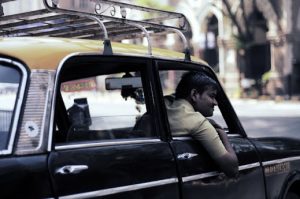
Hindustan Ambassador Car
Daily Streets: Street vendors are everywhere In India, sitting on the walls, floors, alley ways, footpaths and under trees. Indians are highly resourceful and sell everything from food to recycled books and cd’s, and if you really look- reused matches, hair and even teeth! However, the nectar that keeps the Indian engine running is the hot sweet Chai (tea) flavoured with cardamon, cinnamon, cloves and a pinch of garam masala. The aromatic smell and milky flavour is delicious. For those chai wallah’s that are particularly deft, and want their tea making skills to stand out a little from the Indian crowd (population currently 1.2 billion so they have to be impressive!) the tea is poured from a metre high into in tiny terracotta cups. After a long but satisying day of fieldwork, my research students and I would huddle round our favourite chai wallah stall and drink several cups surrounded by the dynamic buzz of the streets. I love chai, and there is no comparison in contrast to the artficial taste and atmosphere of Indian Starbucks. However, if you get the chance, the coffee in South India is excellent too…
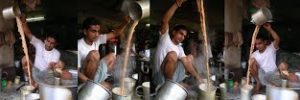
Indian Chai Wallah
Religious Streets: Indian streets also provide a wonderful collective space for annual religious festivals. The religious diversity in India results in a numerous range of celebratory ritruals and some of the main observances I encountered during my fieldwork included Ramadan; the obligitory 30 day salat /talawit prayer and sawm fasting for Muslims which falls in August on the 9th month of the Islamic calendar. This sacred religious time and space represents increased individual and collective spiritual reflection and reading of the Holy Quran, five times a day. The holy month of Ramadan ends with a global celebration of Eid al-Fitr by all Muslims as illustrated below, this woman breaks fast and prays infront of the Jama Masjid in New Delhi. Diwali, the Hindu festival of lights (Oct-Nov) is equally religiously celebrated all over India. For five days and nights the streets are alight with noisy, multi-coloured firecrackers and family celebrations as a ritual blessing for the triumph of good over evil, good luck and eternal light illuminates these Mumbai skies.
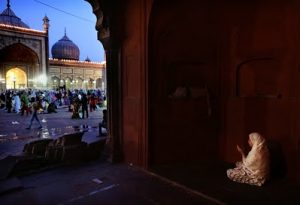
Eid Celebrations, Jama Masjid, New Delhi
Performative Streets: I will always recall in the South Indian city of Madurai, after visiting the sacred Meenakshi temple, I walked around a corner to see this young girl clutching a horizontal pole, with her right foot wedged inside a wheel, 4 pots and a bright orange flower on her head, balancing on a tightrope. As a SOAS anthropology undergraduate I remember studying an anthropology of education module which questioned the global difference in the experience of childhood? As I watched and recorded this young, possibly 12 year old girl’s fragile performance lasting approximately 15 mins, debates associated with the World Health Organisation’s legal definitions and differences between child chores, child labour and child exploitation which shift cross culturally came rushing to my mind. (In India 12.6 million children aged 5-14 years suffer from child labour:2001 National Census).The parents stood watching their daughter perform this illegal activity beneath the thin wire tightrope, clutching a small silver plate filled with maybe 100 rupees (85 rps = £1). Some people walked by and glanced up with indifference to the street entertainment whilst others, particularly shocked tourists (like me) , stopped to linger and watch the stage. Whilst I was present no-one spoke to the parents. After quitely considering the range of causes associated with the growth of an informal Indian economy, I attempted to ask about the why’s and how’s of what was happening? My questions were probably framed by a western industrialised context of childhood, and I was gently pushed back into the amused and growing crowd of onlookers. Sadly I eventually walked away with the literal and metaphorical term ‘A Fine Balance’ not only of showmanship but of humanity, and the title of one of my favourite Indian novels by author Rohinton Mistry (1995) lodged deeply in my mind. http://www.unicef.org/
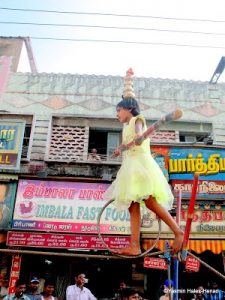
A Fine Balance, Madurai, South India
Ritual Streets: This year during my research in Pondicherry, I was also fortunate to witness a wonderful traditional street ritual called ‘Sedal Thiruvizha’, one of the most significant Tamil festivals to take place annually in Muthu Pallaku, South India during the auspicious Tamil month of Aadi (mid July-mid August). Sedal meaning ‘pierce’ and Thiruvizha ( street) is performed by thousands of male and female Hindu devotees of all castes as fulfilment of a devotional vow to the female deity Sri Mariamman. After a purifying bath, the face, tongue and body are ritually pierced with small and large silver needles or long pointed spears as penance. Sacred ash is smeared on the body of larger piercings to suppress physical scarring and blood, but I didn’t see a drop. Male devotees then participate in a ritual street procession within heavy stainless steel cages, wearing sacred saffron robes to display bodies with up to 100 flesh piercings. Other devotees physically pull the Mariamman temple car or personal vehicles with sharp, curved back hooks and their own body weight. Medics are continually amazed at the rapid healing of these fleshy wounds which display minimal scarification. For devotees the Sedal Thiruvizha festival provides a rite of passage of Hindu religious belief, and for fortunate observers like myself, an unforgettable visual expression of the body as canvas in the ritual streets of South India.
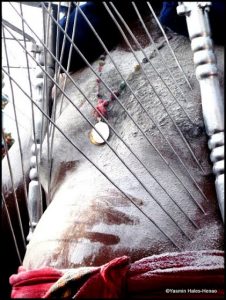
Sedal Thiruvizha Festival, South India
This photograph was my entry for the Body as Canvas Competition 2012 in collaboration with the Education dept at the Royal Anthropological Institute. To see similar visual images in categories ranging from body scarification and piercing to pain please check the website for further details below. https://www.therai.org.uk/
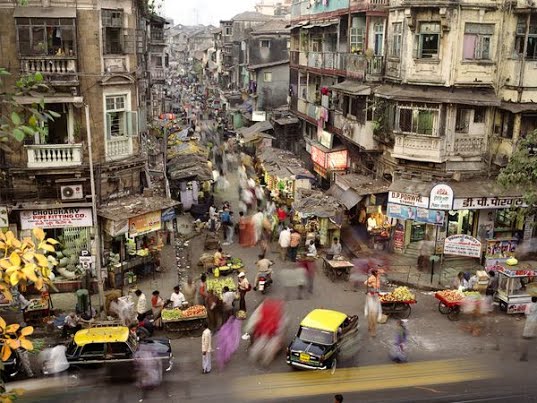
Recent Comments